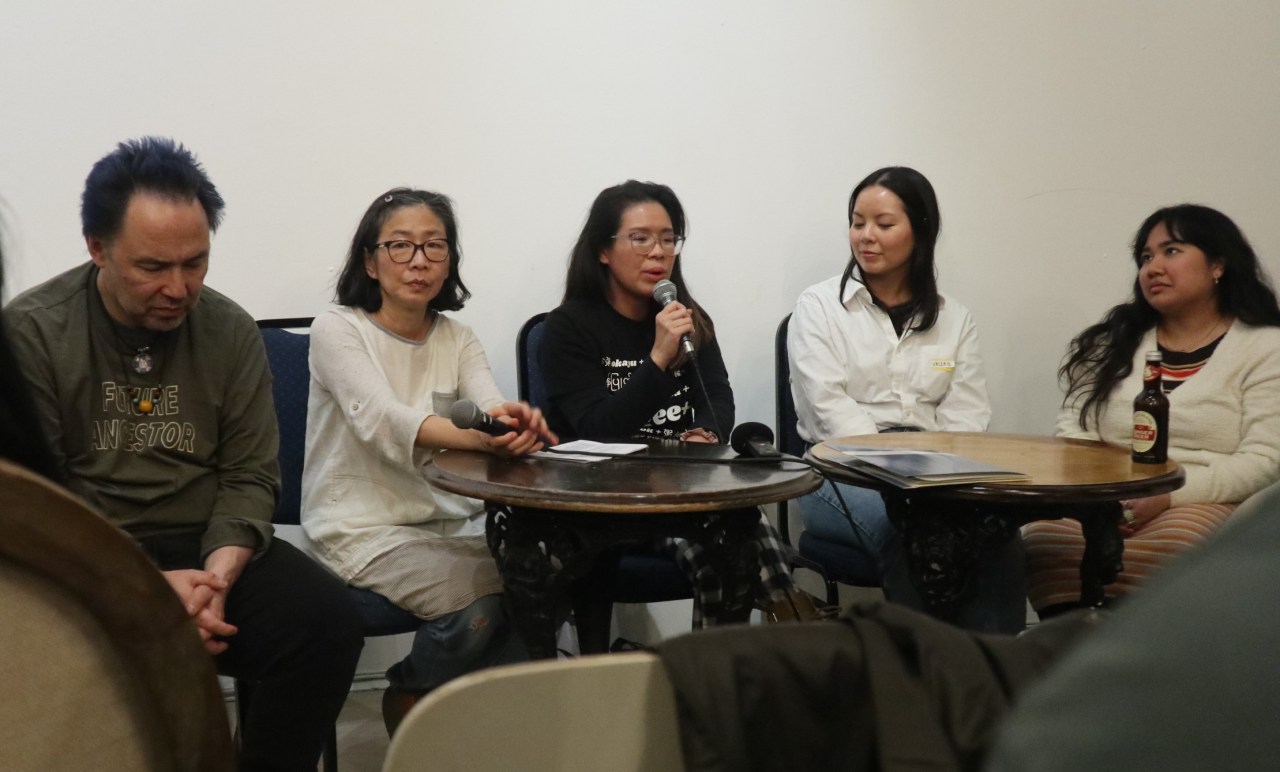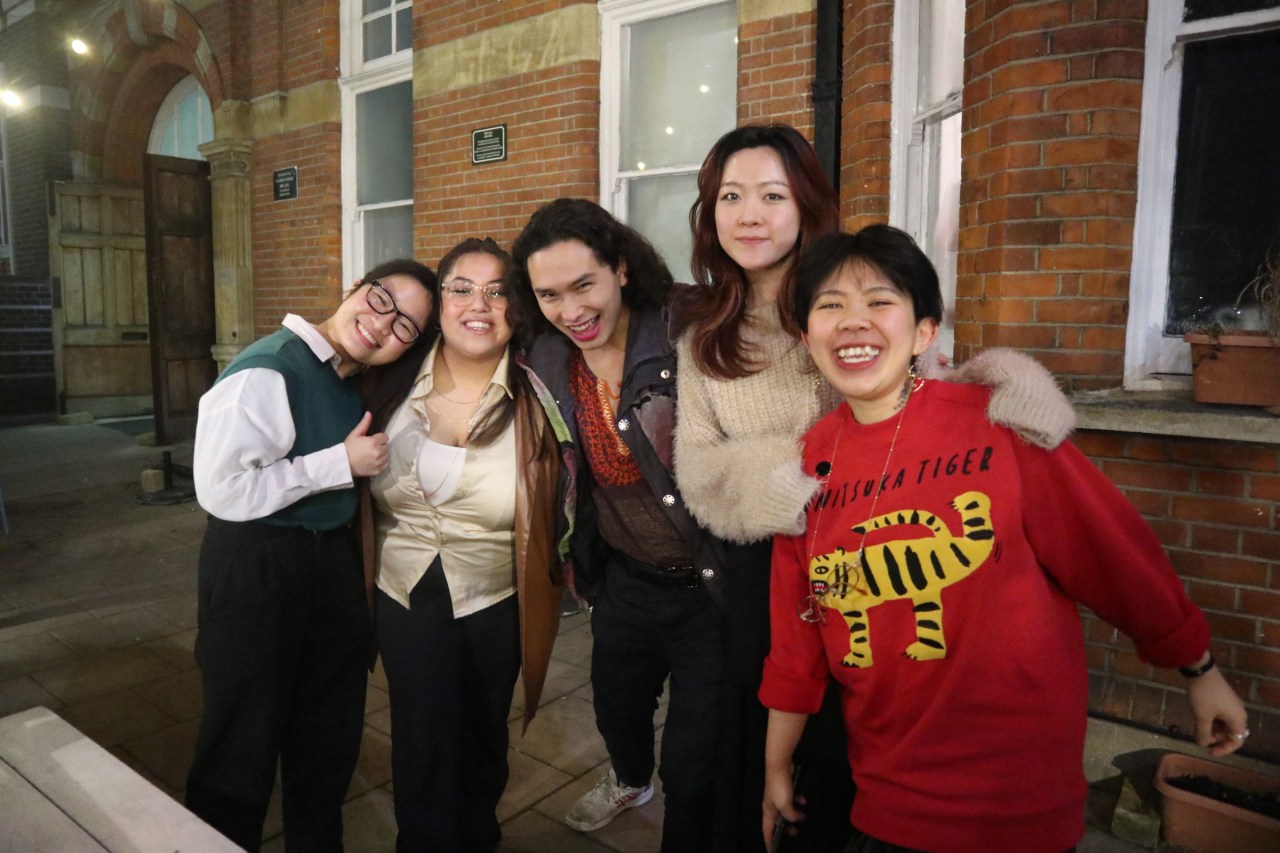by Gilang Desti Parahita
King’s College London, in collaboration with the City University of London, conceived and designed the “I, Human: Becoming Visible” (IHBV) project to respond to anti-Asian racism that has seen a surge since Covid-19. In November 2022, students from KCL and City, together with the members of East Asian and Southeast Asian (ESEA) communities, took part in a development workshop to form groups and to create artistic responses to anti-ESEA racism.
The final showcase and celebration were held at the Omnibus Theatre, Clapham, on February 6, 2023. I, myself, a postgraduate researcher of Culture Media and Creative Industries, took part in the project and performed a poem on the day. I also interviewed Dr Wing Fai Leung and some other performers.

Question (Q): What is the background of the project?
Dr Wing Fai Leung (Fai): In 2021, Victor Fan (Film Studies) and I responded to the KCL Faculty of Arts and Humanities BLM rapid response fund call to do something about raising awareness of anti-ESEA racism among the students. We ended up with a group of 25 students working with the writer/actor David Tse to produce a play called ‘The C-Word’. This was still during one of the heights/waves of Covid, and the students had to collaborate entirely online. After this and a phenomenally successful workshop, it was clear that there was a thirst for more creative projects, but time and resources were hard to find.
I then started to collaborate with Jonathan Gray (Department of Digital Humanities, KCL) and Diana Yeh (City, University of London) on other ESEA-related research and activities. In 2022, I led the fundraising for a collaborative, creative project. Moongate Productions came on board. It was lucky that Jennifer Lim and Daniel York Loh were enthusiastic about supporting the project in terms of their leadership of the development workshop and mentoring of the participants. Since they are artists in residence at the Omnibus, we were able to showcase our work at the Moongate Mix event.
Through the project, we would like participants to work on their pieces and tell their own stories. The main aim was to engender a caring collaboration and for ESEA people to celebrate, create and build resistance and solidarity. The title ‘I, Human: Becoming Visible’ was born out of thinking about shared experiences and the visibility of the ESEA community in the UK.

Q: How many students and practitioners were involved?
Fai: We recruited 30 participants, roughly 10 each from KCL, City and the community. That was intentional – I am immensely proud of how the project was able to draw people together who wouldn’t otherwise have met or worked together. The two universities and the student cohorts are also quite different, so it was a great achievement to collaborate with Diana and the ESEA Online Community Hub.
Q: What are their heritage backgrounds?
Fai: Their backgrounds are remarkably diverse regarding ethnic/national origins: Hong Kong, China, Taiwan, Vietnam, the Philippines, Indonesia, Singapore, Indian subcontinent (but have family ties in SE Asia). These origins are not all: some participants are born and brought up entirely in the UK; some have moved to the UK (perhaps via other countries) with their families for work and education. Some are of mixed heritage. The only uniting feature was their identifying with being ESEA.

Q: Why is this project special?
Fai: A participant said, “It has been a pleasure so far to be a small part of ‘I, Human’, and to be collaborating with such a wonderful group to create our piece.” That might sum up how this achieved the project’s aim to be a small step towards solidarity.
The development workshop in November 2022 was great, although we could do it with a much longer event. Through guidance from Jennifer and Daniel, people created awesome works. Many participants did not have or had minimal experience with artistic practices, which made it all the more special the films and performances they created, given time and resource constraints. The Moongate Mix event was cathartic – as a forum for participants to present their pieces and for the participants, organisers, and friends and families to share food, laughter and many meaningful conversations and thoughts on and off-stage. I was moved to tears (of joy and recognition of shared experiences) many times.
Q: Where can we access the outputs of the project?
Fai: We plan to have as many of the outputs and recordings of the panel discussion available on the following as possible: the online ESEA hub, Moongate’s YouTube, and the CMCI YouTube
Q: Will there be any similar projects that you participate in in the future?
Fai: I would love to have an IHBV volume 2, though it will take time to fund-raise. In the meantime, my collaboration with Jonathan and Diana continues. Various conversations have started about ESEA Heritage Month in September 2023.
One poem, two live performances, and three movies were staged and screened at Omnibus Theatre on February 6, 2023. I managed to interview Georgina Quach, who, together with Hanna Pham, produced a 10-minute documentary movie about the 2022 Christmas Celebration of the Philippine community in London. I also had a short conversation with Roann Guiterrez, Ngan Nguyen, Carly Lam, Alex Blanc and Khánh Hạ Nguyễn, who performed an honest dialogue on their intimacies and identities as members of the ESEA community.

Question (Q): Why did you choose the subject for the documentary?
Georgina (G): Our project began after the workshop at City University, it was groups of us from East and Southeast Asian backgrounds that came together, to celebrate our heritage and cultures. We got into groups and two of us wanted to do something around migration and refugees, particularly in the United Kingdom. So, we decided to go for a film format. We have both come from journalistic backgrounds. We wanted to make a documentary film that represented a sector of migration in the UK. In December last year, we visited a Filipino Christmas party, hosted by Kanlungun. We filmed quite a bit of the event, the games, and the excitement of that evening, and we put it together into a film. Hopefully, it captures some of the importance of getting together on Christmas evening and supporting those who cannot go home to visit their families.
My heritage background is Vietnamese, while my partner in the project is Vietnamese-Filipino. We had not known about the community until we came across the information about the Kanlungun event on social media, they said it would be a glamorous party so it would be fun to go and cover it.
Q: What is the key message that you want to share with your audience?
G: The key message we wanted was joy and celebration. Sometimes the joys around migration are quite difficult. They are often quite sad and tragic. And we wanted to show awareness of that. But we want also to recognize the magnificent work of migrant charities to counter that sadness and to give the community a space to be who they are.
Q: How do you think about the event?
G: This kind of event used to be rare, and kind of only happen in much smaller communities but there is much more awareness and visibility of East and Southeast Asian communities in London and around the UK. A lot of work still needs to happen, and a lot more allyship. I have noticed this year has been a lot more engagement from other people who want to get to know about film, music, and dancing, all distinct parts of East Asian and Southeast Asian culture. It needs to be pushed into the mainstream more, but I do not think it is too rare.
Q: What do you hope for the future of ESEA in London?
G: I think the first is tackling racism and violence. It is not enough energy for devoted politicians and leaders to reach out to the survivors, and victims, and help them process what happens. Not all communities have the resources, so politicians need to be more proactive in interacting with the community in vulnerable situations. And of course, we need more platforms for the communities to engage more with each other.
Further information about Kanlungan can be found here.

Q: What was the main message you wanted to deliver to your audience by ‘performing’ a dialogue on intimacy and identity?
Alex Blanc (AB): There is no message. What we were trying to do is we wanted to start a conversation. We wanted to talk about things as a community that we do not usually talk about. The message is we need to be honest with ourselves, even though, I feel like –I do not know how you folks– but I think for us, things are better than they were before. Because things start to get better and are progressing, it does not pretend what had happened before never happened.
Carly Lam (CL): We chose this format because we do not talk enough about it. When we talk about it, the discourse is either academic or political. What we did might be an art, but we could also just talk about it, the multifaceted problems that we face. Not only problems but everything that we face, that we might not even think about until someone voices it.
AB: Through this project, we learn about each other, and I also learn about myself.
Q: So, what you ‘performed’ on stage is honest and natural. How do you feel about the performance?
CL: We have different things to say; we are starting a dialogue. It does not matter whether it is a good or bad opinion. We just shared our experiences. Everything we said is not necessarily right or wrong. The aggrievances we had, the regrets, the opportunities of the future.
Nguyen Khan (NK): When I think about it, it is interesting because when we came up, we were total strangers. But we also can talk about it in a close way, so why not talk about ourselves and our families, like the way we do it? We can always do it, but we cannot because we need some chances to voice it.
Q: Do you think sharing feelings or talking about sensitive issues is more difficult in your communities than with strangers?
Khánh Hạ Nguyễn (KHN):I think the process I had gone through in the project is a kind of practice for me to talk about myself in my family. It is like workshopping myself before talking to my parents. But I think it would be nice for whoever needs it that, oh, there is somebody with a language I did not have! When I was younger, I wrote poetry and fictional characters to know that there are people out there who share the same experiences as I have.
(GDP)

Leave a comment